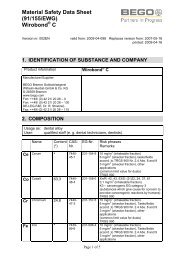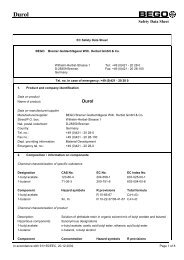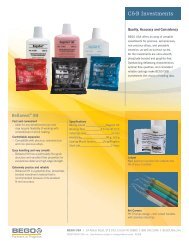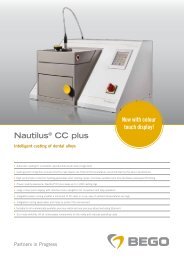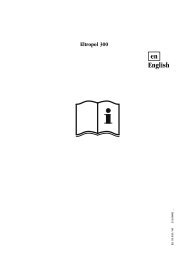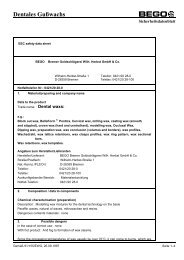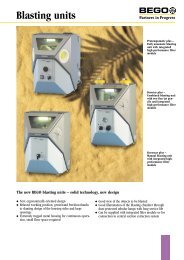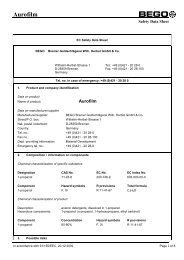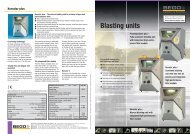Fluxsol MSDS - Bego USA
Fluxsol MSDS - Bego USA
Fluxsol MSDS - Bego USA
- No tags were found...
You also want an ePaper? Increase the reach of your titles
YUMPU automatically turns print PDFs into web optimized ePapers that Google loves.
<strong>Fluxsol</strong>Safety Data SheetEC Safety Data SheetBEGOBremer Goldschlägerei Wilh. Herbst GmbH & Co.Wilhelm-Herbst-Strasse 1 Tel.: +49 (0)421 - 20 28-0D-28359 Bremen Fax: +49 (0)421 - 20 28-100Germany1. Product and company identificationTel. no. in case of emergency: +49 (0)421 - 20 28 0Data on productName of product:<strong>Fluxsol</strong>Data on manufacturer/supplierManufacturer/supplier:BEGO Bremer Goldschlägerei Wilh. Herbst GmbH & Co.Street/P.O. box: Wilhelm-Herbst-Strasse 1Nat. postal code/town:D-28359 BremenCountry:GermanyTel. no.: +49 (0)421 - 20 28-0Fax no.: +49 (0)421 - 20 28-100Dept. providing information: Material DevelopmentEmergency tel. no.: +49 (0)421 - 20 28-02. Composition / information on componentsChemical characterization of specific substanceDesignation CAS No. EC No. EC Index No.Potassium hydrogen difluoride 7789-29-9 232-156-2 009-008-00-9Ethylene glycol 107-21-1 203-473-3 603-027-00-1Component Hazard symbols R provisions Total formulaPotassium hydrogen difluoride T, C R 25-34 F2HKEthylene glycol Xn R 22 C2H6O2Chemical characterization of productDescription:Hazardous components:Complex mixture, contains potassium hydrogen difluoride and ethylene glycolpotassium hydrogen difluoride (potassium bifluoride, hydrogen potassiumfluoride, potassium acid fluoride)ethylene glycol (ethandiol)Component Concentration Hazard symbols R provisionsIn accordance with 91/155/EEC, 20.12.2002 Page 1 of 8
<strong>Fluxsol</strong>Potassium hydrogen difluoride < 5% C R 22-34Ethylene glycol 1% - -3. Possible risksDesignation of hazardsHazard identification: C causticXn harmful to healthSpecial indications of risk for people and environmentCauses acid burns. Harmful to health if swallowed.Specific risksPossible harmful impact on people and possible symptoms:Acid burns must be treated immediately, otherwise wounds that are difficult to heal result. Skin contact andinhalation of aerosols/vapours of the preparation should be avoided. During work wear suitable protectiveclothing, safety gloves and safety goggles / face screen.4. First aid measuresGeneral instructionsCall in physician immediately. In case of risk of unconsciousness, place and transport person in a lateralrecovery position. Remove dirty, soaked clothing immediately. In the event of contact with the eyes, rinsethoroughly with water and consult a physician. In the case of an accident or indisposition, call in a physician atonce (if possible, show this label). In case of cessation of breathing, place person on back, overstretch head,mouth-to-nose respiration. Do not carry out mouth-to-mouth respiration.After inhalationRemove person to fresh air at once. In case of cessation of breathing, carry out artificial respiration. In eventof difficulty with breathing, administration of oxygen if necessary. Keep person warm. Have person rest. Callin physician immediately.After skin contactIn case of contact with the skin, wash off with plenty of water for at least 15 minutes. Dab with polyethyleneglycol 400. Remove contaminated clothing at once. In any case call in physician. Acid burns that are nottreated lead to wounds that are difficult to heal.After eye contactIn the event of contact with the eyes, rinse eyes under running water with eyelids open for at least 15minutes. Consult an eye doctor at once.After swallowingDo not induce vomiting. Immediately rinse mouth thoroughly with water. Have person drink plenty of water (atleast 0.5 l) in small sips (dilution effect). Obtain medical assistance at once. Rest, warmth, place andtransport person in lateral recovery position.Remove contaminated clothing while rinsing continuously with plenty of water.Symptoms of acid burns may not emerge until many hours later, therefore medical supervision for at least 48hours after accident.In accordance with 91/155/CEE, 20.12.2002 Page 2 of 8
<strong>Fluxsol</strong>5. Fire-fighting measuresSuitable extinguishing agentsCO 2 , fire extinguishing powder, water spray or foam. Adapt fire-fighting measures to surroundings. Suppressvapours with spray jet.Special risk due to substance or the product itself, its products of combustion or resulting gases, furtherinformationThe product itself is not combustible. Hazardous vapours may form due to ambient fire. In the event of fire,hydrogen fluoride (HF) may be released. In case of contact with light metals, hydrogen gas may form (risk ofexplosion).Special protective equipment for fire fightingUse suitable breathing apparatus that is independent of ambient air. Use protective clothing for fire-fighting soas to avoid skin and eye contact. Stay in the danger zone only with suitable, impervious chemical protectionsuit.Other instructionsAvoid penetration of fire-fighting water in surface waters or groundwater.6. Measures in the event of unintentional releasePersonal precautionary measuresAvoid contact with substance. Do not pick up with unprotected hands. Wear protective clothing in accordancewith section 8 of this safety data sheet.Environmental protection measuresDo not allow to enter sewer system or waterbodies.Cleaning/collection procedureCollect mechanically with liquid-binding material (e.g. sand, clay mineral, diatomaceous earth, vermiculite,universal binder). Put leaky receptacles, residues and contaminated material in identified and sealablecontainers. If necessary, clean again. Disposal as waste in accordance with section 13 of this safety datasheet.7. Handling and storageHandling – instructions for safe handlingOnly use in well ventilated areas. Keep work area well ventilated when soldering. Suction-extract anddischarge safely vapours/aerosols directly at the site of generation. Do not allow paste to dry out. Avoidcontact with eyes and skin. Do not inhale gas/smoke/vapour/aerosol.Handling – instructions regarding fire and explosion protectionThe product is not combustible. Keep away from ignition sources – do not smoke.Storage – storeroom and container requirementsKeep under lock and key. Keep containers tightly sealed and store in a cool, dry and well ventilated place.Unsuitable material for containers/equipment: aluminium, tin or zinc. VCI storage class: LGK8BS – Noncombustiblecaustic substances (solid).In accordance with 91/155/CEE, 20.12.2002 Page 3 of 8
<strong>Fluxsol</strong>8. Exposure control and personal protective equipmentComponents with workplace-related or biological limit values that must be monitoredTRGS 900 (maximum permissible workplace concentration – MPWC):Scope of application: fluorides (calculated as fluorine)MPWC of fluorides: 2.5 mg/m 3 breathable dust portionPeak limitation:excess factor 4 (The mean concentration shall not exceed the fourfold limitconcentration in any 15-minute period.)Limitation and monitoring of exposureSee section 7. No measures beyond that are necessary.Personal protective equipmentRespiratory protectionRespiratory protection is necessary if there is increased concentration in the air and dust is generated.Type of mask: full mask (DIN EN 136) or half-mask (DIN EN 140).Respiratory protection filter: filter class E 2 (acid gases) or P2 (particles).Hand protectionUse solvent-resistant safety gloves made of NBR (nitrile rubber) or butyl (butyl rubber) with at least 10 cmlong sleeve.Eye protectionTightly sealing safety goggles with lenses made of safety glass.Body protectionWear acid-resistant, impervious protective work clothing. Protective aids for the body are to be selecteddepending on the concentration and amount of hazardous substance and according to the specificworkplace. Pay attention to chemical resistance of the protective aids (suppliers).General safety and hygienic measuresAvoid contact with eyes, skin and clothing. Remove contaminated and/or soaked clothing at once. Keep awayfrom food. Do not eat, drink, smoke or take snuff during work. Wash hands before breaks and at the end ofwork. Preventive skin protection by means of protective skin ointment. Further suitable skin care measuresaccording to code of practice “Skin protection” of the employer’s liability insurance association (e.g. BGChemie [employer’s liability insurance association for chemical industry] No. M 042). Minimum standards forprotective measures when handling working substances are listed in TRGS 500 (Technical Rules forHazardous Substances).9. Physical and chemical propertiesNon-combustible, pasty solid. Soluble in water. Hygroscopic in dry state. Aqueous solution has acidicreaction. The solution with potassium hydrogen difluoride has a more corrosive effect than that withpotassium fluoride.AppearanceState:Colour:Odour:pasty, viscouswhiteodourlessIn accordance with 91/155/CEE, 20.12.2002 Page 4 of 8
<strong>Fluxsol</strong>Important data on health and environmental protection and on safetypH value:5.3 (50% aqueous solution)Flash point:not applicableExplosion limits:not applicableDensity.1.6 g/cm 3 (20°C)Aqueous solubility:can be mixed without restrictionMelting temperature DensityPotassium hydrogen difluoride 239°C 2.37 g/cm 310. Stability and reactivityConditions to be avoidedDo not allow paste to dry out. No further data available.Substances to be avoidedMaterials containing glass and silicate are corroded. In case of contact with strong acids: formation ofhydrogen fluoride. Pay attention to pungent odour!Hazardous decomposition productsNo decomposition given proper use. Reaction with strong acids: formation of hydrogen fluoride. Suctionextractvapours and discharge safely. Decomposition products in event of fire: see section 5.Further informationDry product is hygroscopic. Incompatible with metals, various plastics, glass, animal/plant fibres.11. Toxicological informationThe product has a caustic and harmful effect on the mucous membranes of the eyes and the respiratoryorgans. In the event of skin injuries and mucous membrane contact, toxic and caustic effect must beexpected; if swallowed, damage in the gastrointestinal tract and intoxication must be expected. Harmful ifswallowed, inhaled or in the case of contact with the skin. The main component, potassium hydrogendifluoride, poses acute or chronic risks to health.Further toxicological informationAfter inhalationCauses acid burns to the mucous membrane and may be harmful if inhaled. Inhalation may lead to spasms,inflammation and oedema of larynx and bronchial tubes, chemical pneumonia and pulmonary oedema.Extremely damaging effect on the tissue of the mucous membranes and upper respiratory tracts as well ason eyes and skin.After skin contactCauses acid burns and may be harmful in the event of intake via the skin.After eye contactCauses acid burns. Risk of corneal clouding. Risk of blindness!After swallowingCauses acid burns and is harmful if swallowed in the mouth, throat, oesophagus and gastrointestinal tract.In accordance with 91/155/CEE, 20.12.2002 Page 5 of 8
<strong>Fluxsol</strong>Tissue damage. Risk of perforation for oesophagus and stomach. In the event of intake of large amounts ofpotassium ions, risk of reduction in blood pressure, coma and death.After resorptionHeat sensation, spasms, coughing, headache, cardiac dysrhythmia, shock, unconsciousness. If allowed toreact for a longer period: damage to bone marrow. For soluble inorganic fluorides the following generallyapplies: Contact with eyes, skin and mucous membranes leads to irritation or even acid burns. Symptoms ofexcessive exposure to fluorides are salivation, nausea, vomiting, abdominal pains, fever, shortness of breathand cessation of breathing. Systemic effect of fluoride ions: reduction of blood serum-calcium level with riskof fatal hypocalcaemia, excitation, spasms, cardiovascular disorders, central nervous system disorders.Exposure to fluoride dust, vapours or mist for a longer period leads to perforation of the nasal septum.Chronic effects include excessive calcification of the bones, ligaments and tendons.Organs affectedKidneys, heart, bones, nerves, gastrointestinal tract, teethFurther informationThe product must be handled with special care.12. Ecological informationEcotoxic effectsHarmful effect on water organisms. Toxic effect on fish and plankton. Harmful effect due to pH shift. In spiteof dilution, still forms caustic mixtures with water. Does not cause any biological oxygen depletion.Neutralization possible in treatment plants. Hazardous for drinking water. Do not allow to enter waterbodies,sewer system or soil!Biological effects – data for potassium fluorideFish toxicity: fish LC50 > 2.3 mg/lProtozoa Entosiphon sulcatum EC 5 : 101 mg/lFurther ecological informationBiological effects for inorganic fluorides (all data as sodium fluoride):Fish toxicity: L. idus LC50 = 660 mg/LBacterial toxicity: Ps. putida toxic from 231 mg/l and upAlgae toxicity: Sc. quadricauda toxic from 249 mg/l and upProtozoa toxicity: E. sulcatum toxic from 101 mg/l and upU. parduzczi toxic from 71 mg/l and upBiological degradabilityMethods for determination of biodegradability are not applicable for inorganic substances.Behaviour in the environmentAccumulation in organisms is not expected.13. Disposal considerationsProductUniform regulations on disposal of chemicals in the Member States of the EU do not exist. In Germany therequirement of recycling is stipulated by the Closed Substance Cycle and Waste Management Act. TheIn accordance with 91/155/CEE, 20.12.2002 Page 6 of 8
<strong>Fluxsol</strong>Class: 8Classification code:CT2Packaging group:IIHazard label: 8 + 6.1Remark:Product is pasty in accordance with 2.3.4 ADR/RIDMaritime shipping transport (IMDG code)UN no.: 1811Proper Shipping Name:POTASSIUM HYDROGEN DIFLUORIDE, SOLID, MIXTUREClass: 8Packaging group:IIEmS no.: 8-06Marine pollutant:NoHazard identification: 8 + 6.1Remark:Product is pasty in accordance with 2.3.4 ADR/RID (not a liquidsubstance in accordance with 1.2.1 IMDG code)Air transport (ICAO-TI/IATA-DGR)UN / ID no.: 1811Designation of product:POTASSIUM HYDROGEN DIFLUORIDE, SOLID, MIXTUREProper Shipping Name:RESIN POTASSIUM HYDROGEN DIFLUORIDE, SOLID, MIXTUREClass: 8Packaging group:IIHazard identification:corrosive (RCM), toxic (RPB)Remark:Product is pasty in accordance with 2.3.4 ADR/RID (not a liquidsubstance in accordance with Annex A IATA-DGR)Further informationThe product is not approved for postal delivery.15. Regulatory informationThe product was classified according to the specifications of the Dangerous Substance Directive (ECDirective 67/548/EEC, Annex I). Hazard-determining component for labelling: potassium hydrogen difluoride(caustic C; toxic T).Labelling according to EC directivesHazard symbols: C causticR provisions: R 34 Causes acid burns.R 22 Harmful if swallowed.S provisions: S 1/2 Keep under lock and key such that inaccessible to children (ifdesigned for the general public).S 22 Do not inhale dust.S 26 In the event of contact with the eyes, rinse thoroughly with water atonce and consult a physician.S 37 Wear suitable safety gloves.S 45 In event of accident or indisposition call in physician immediately(show this label if possible).German regulationsIn accordance with 91/155/CEE, 20.12.2002 Page 8 of 8
<strong>Fluxsol</strong>The national legal regulations must additionally be observed!Employment restriction:Hazardous Incident Ordinance:Classification acc. to VbF:Clean Air Directive:Water hazard class:Comply with Section 22 of Youth Employment Protection Law (JarbSchG)and Section 5 of Maternity protection Guideline Regulation (MuSchRiV)!Product is not subject to Hazardous Incident Ordinance.Product is not subject to VbF.Not applicable.WGK 1 (low degree of water endangerment)classification of the components in accordance with AdministrativeRegulation on the Classification of Substances Hazardous to Waters(VwVwS), Annex 2potassium hydrogen difluoride (identification no. 342: WGK 1)Other national regulationsSwiss toxin class: 3Miscellaneous regulations, restrictions and prohibitory regulationsVCI storage class:LGK8BS – Non-combustible caustic substances (solid)BG-Chemie codes of practice: M004 Irritating substances / caustic substancesM005 Hydrogen fluoride, hydrofluoric acid and inorganic fluoridesM050 Handling harmful substancesM051 Hazardous chemical substancesApplication restrictions:The product may be used exclusively as a flux for soldering dental alloysin the dental laboratory.16. Other informationData sheet issued by:Material Development DepartmentContact person:Dr. Thomas WiestReasons for change:Complete revisionRevised on: 20.12.2002Replaces issue dated: 22.11.1999The data are based on the current level of our knowledge. They are intended in particular to describe ourproduct with regard to the hazards related to its use and the safety precautions to be taken. They do notrepresent any guarantee of product and quality characteristics.In accordance with 91/155/CEE, 20.12.2002 Page 9 of 8



